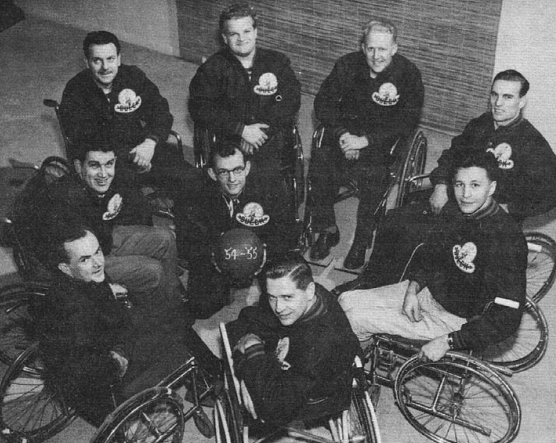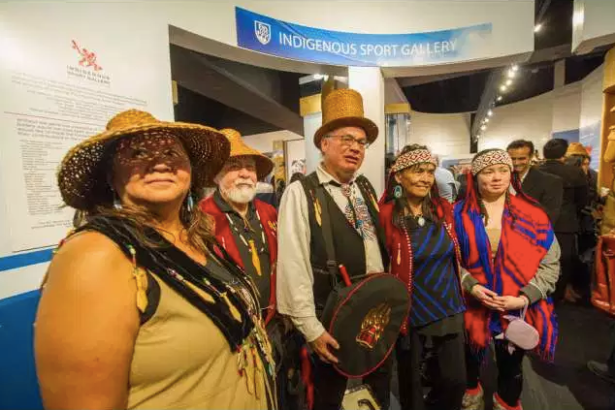Richard Peter is an incredible Canadian athlete. His high-level accomplishments representing Canada in wheelchair basketball include 4 Paralympic medals (3 Gold, 1 Silver) as well as several podium finishes for both national and international competitions. Richard Peter not only represents Canada but proudly identifies as a member of the Cowichan Tribes of British Columbia and has been recognized as an outstanding Indigenous athlete. Also known as “Bear” to his teammates due to his incredible strength, and apparent large heart, his introduction to wheelchair basketball occurred in 1987. A touring wheelchair basketball group visited Richard’s high school in Duncan, BC including him in a demonstration. When Richard held his own on the court, the team encouraged him to join them for training in Victoria.
Sport History: Wheelchair Basketball in Canada/Australia
The history of wheelchair basketball in Canada (majorly in British Columbia) began in the 1950s with the formation of two teams: The Dueck Powerglides (Vancouver) & The WheelChair Wonders (Montreal). The Dueck Powerglides played only able-bodied opponents at first, but after gaining some traction with the public began arranging exhibition games with Montreal’s team. Canada sent its first men’s wheelchair basketball team to the Paralympics in 1968 followed by the first women’s Paralympic team in 1972. Throughout the 80’s and 90’s wheelchair basketball saw a further push for recreational training beyond urban cities and new competitive opportunities at all levels.
However, the racial history of wheelchair basketball in Canada is lacking. Finding biographies of past para-athletes proved to be quite difficult. From what I could dig up, the original roster of the Dueck Powerglides was composed of predominantly, seemingly solely white men.

Original Roster for the Vancouver Dueck Powerglides
Similar trends appear in past Canadian Paralympic rosters and amongst publically significant athletes. Further research into the racial history of wheelchair basketball in Canada, turned up relatively nothing because according to my intensive internet search, Richard Peter is the ONLY relevant Indigenous para-athlete. Not only in the realm of wheelchair basketball but repeatedly in the history of recognized Indigenous para-athletes in Canada.
In Australia, a nation similar in its struggles with respecting and representing its Indigenous peoples, it took until 2015 to have a permanent recognition of its Indigenous Para-athletes. Revealing a total of only 11 name plaques, many of the athletes spoke to the concealment of their Indigenous heritage during their active careers, as one athlete (Tracy Barrel, gold medalist in swimming 1992 Paralympics) recounted:
“No one understood the culture and [the games] were mainstream white, from the dealings and the protocols. No one did a ‘Recognition of Country’ or highlighted cultural background at all.”
In Canada, we have yet to create a similar display. It’s apparent that the racial history of wheelchair basketball and para-athletics is not diverse. One potential contributing factor to the overall whiteness of para-sports is the reality that participation is based on class and access to resources.
Para-athletics: A rich man’s game?
In my opinion, Richard Peter’s story is important due to his intersections of Indigenous heritage and physical disability. When recollecting his youth Peter states he was the only person using a wheelchair in his community. However, according to Titchkosky (2001), a census of Canada in the 90’s stated that approximately 30% of the country’s Indigenous population reported experiencing a disability (almost double the national standard). If there is such a large population of Indigenous individuals with disabilities shouldn’t there be a greater representation in para-sport?
The Aboriginal Sport for Life: Longterm Participant Development published some recommended guidelines in 2016 to address the apparent gaps in developing and applying sports-related activities for Indigenous peoples in Canada. In terms of increasing participation for Indigenous individuals with disabilities the guide enforced the importance of proper equipment stating:
“[Introducing] athletes with disabilities to specialized sport-specific equipment such as racing wheelchairs and athletic prostheses. For all athletes, the use of body-size and skill-level appropriate equipment remains important.”
Sports wheelchairs and other necessary equipment for para-sports tend to be very expensive and organizations often rely on private funding, that also goes towards proper training facilities, in order to support higher-level para-athletes (Buts et al., 2011). Therefore when comparing the price of entry for para-sports to the average household income for Indigenous families, which has been studied and proven to be substantially lower than that of their non-Indigenous counterparts in Canada, participation is improbable (Adelson, 2005).
Media outlets have begun to publish stories on this matter as the lack of lower income countries at past Paralympics has become noticeable. An article put out before the 2012 London Paralympics exposed the event, that supposedly promotes inclusion and fairness, to often sideline poorer nations, such as Cambodia, that are full of talented and ambitious athletes that simply lack “the kit.” Swartz et al (2016), analyzed levels of both participation and achievement for the 2015 International Paralympic Committee’s Athletics World Championships and found that “economic classification and GDP [were] significant predictors.”
Therefore, Richard Peter’s prevalence in Canadian para-athletic history, unaccompanied by other Indigenous athletes, may be in part due to struggles with the financial upkeep of para-sport. Many people believe that such lack of representation will self-correct over newer generations, but I believe Peter’s experiences during his career speak to the ineffectiveness of generational change as well as his public tours post-retirement and who he’s been chosen to role model for.
Themes of Whiteness throughout and after Richard Peter’s Athletic Career
Some people may argue that with ‘changing times’ this lack of diversity within Canadian para-sports will lessen, however, Peter’s solo representation of Indigenous Para-athletes has also been apparent during recent Paralympic Games. In 2008, Canada’s Paralympic team had Richard Peter as the only Indigenous para-athlete representative in Beijing. This represents the lack of a continual, steady increase in Indigenous representation at a Paralympic level since the beginning of the games. Therefore it is likely that the proposed initiatives to change these statistics if there even were any (none were apparent when I was researching), focused on measures of diversity instead of racial justice. Wrench (2005), discusses the realities of diversity vs racial justice by putting the two terms on a scale: the recognition of cultural differences at one ‘softer’ end (diversity) vs target setting as well as the use of positive action at the ‘harder’ end (racial justice).
Whiteness still prevailed for Richard Peter even after retirement from an elite athletics career. Peter states that when he’s not training he often speaks to youth on his experiences as an athlete. While I can imagine he is a great role model, what catches my eye is who he’s chosen to be a role model for. Although he’s an incredibly decorated Canadian athlete he is:
From this statement, it is obvious that Richard Peter is viewed first by his level of ability, second by his race, and lastly by his athletic success.
Potential Ways forward in Para-sport for Canada
In terms of increasing Indigenous representation throughout para-sport in Canada, I believe reconciliation must occur on two fronts: record keeping and public exposure.
To once again bring Australia back into the conversation, both their National Library of Australia and the Australian Paralympic Committee collaborated to head an oral history project through conducting interviews with key Australians who have contributed to the Paralympic Movement while also discussing their placement in the larger society (Jobling et al. , 2012). This large-scale effort to record and promote the history of para-sport in Australia is a great initiative to increase the Indigenous experience in such a realm as this method of record keeping realizes the importance of focuses on:
“narratives from actual participants, rather than proxy or interpretive accounts from those who do not have a disability, are recorded by interviewers sensitive to the situational context and the objectives of socio-historical research,” (Goodwin, 2009).
For public exposure, some examples of reconciliation have begun in Canada. As of September 25th 2018, the British Columbian Sports Hall of Fame (Richard Peter has been an inductee since 2010) now has an Indigenous Sports Gallery.

Opening Ceremony for the Indigenous Sport Gallery
This new gallery, spanning 1000 sq ft, highlights the outstanding careers of Indigenous athletes in BC’s sports history and has an exhibit dedicated to outlining all previous Indigenous inductees. This new installment, its predecessor being a 300 sq ft Aboriginal Sports Gallery, allows Indigenous athletes to take up more space in a predominantly white environment while also providing exposure to educate unaware individuals and to inspire future Indigenous athletes of all levels of ability.
Academic References:
Adelson, N. (2005). The embodiment of inequity: Health disparities in Aboriginal Canada. Canadian Journal of Public Health/Revue Canadienne de Sante’e Publique, S45-S61.
Buts, C., Bois, C. D., Heyndels, B., & Jegers, M. (2013). Socioeconomic determinants of success at the Summer Paralympics. Journal of sports economics, 14(2), 133-147.
Goodwin, D. (2009). The voices of students with disabilities: Are they informing inclusive physical education practice?. In Disability and youth sport (pp. 65-87). Routledge.
Jobling, I. F., Naar, T., & Hanley, M. (2012). The Australian Paralympic Oral History Project: Remembering, reflecting, recording and promoting disability in sport. International Journal of Disability, Development and Education, 59(3), 295-303.
Swartz, L., Bantjes, J., Rall, D., Ferreira, S., Blauwet, C., & Derman, W. (2016). “A More Equitable Society”: The Politics of Global Fairness in Paralympic Sport. PloS one, 11(12), e0167481.
Titchkosky, T. (2001). Disability: A rose by any other name?“People‐First” language in canadian society. Canadian Review of Sociology/Revue canadienne de sociologie, 38(2), 125-140.
Wrench, J. (2005). Diversity management can be bad for you. Race & Class, 46(3), 73-84.
